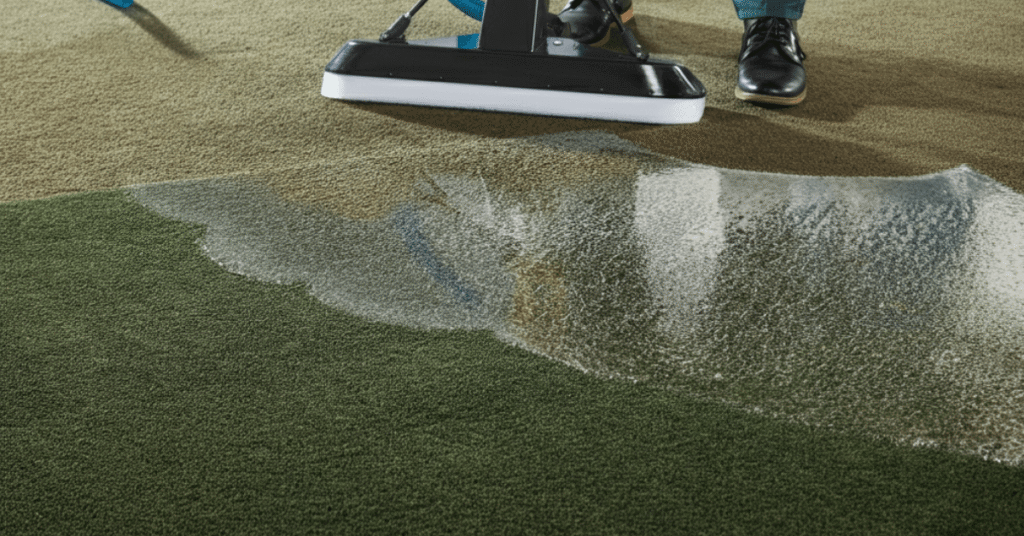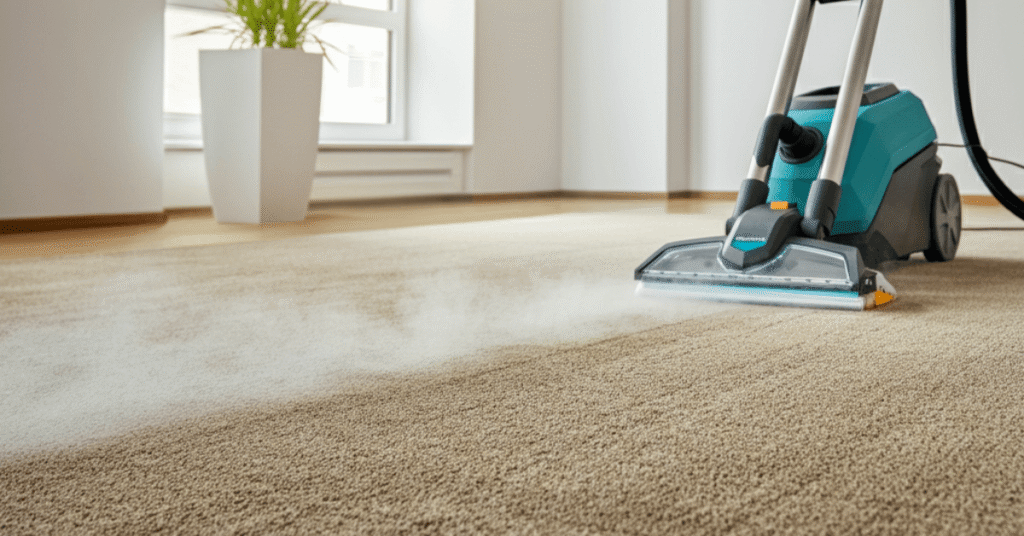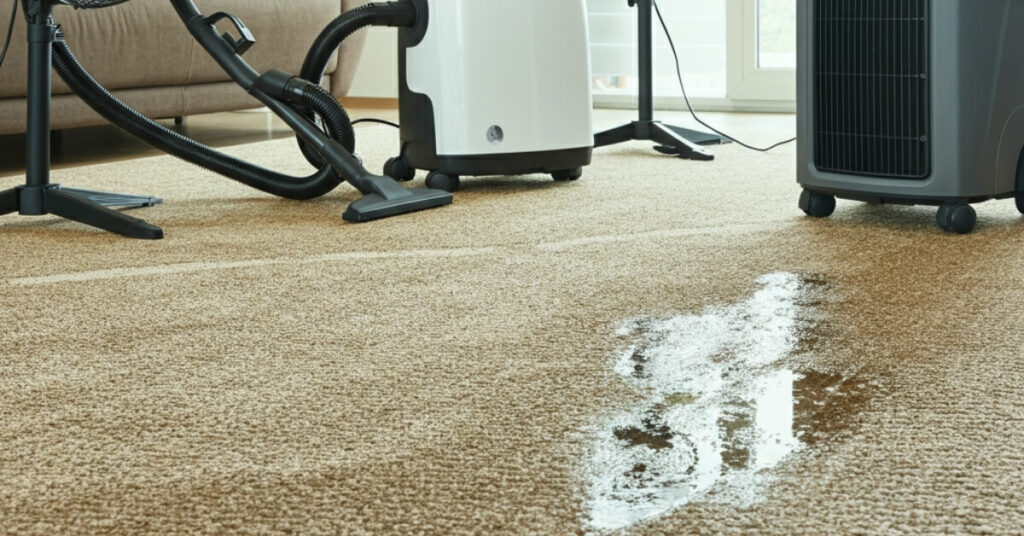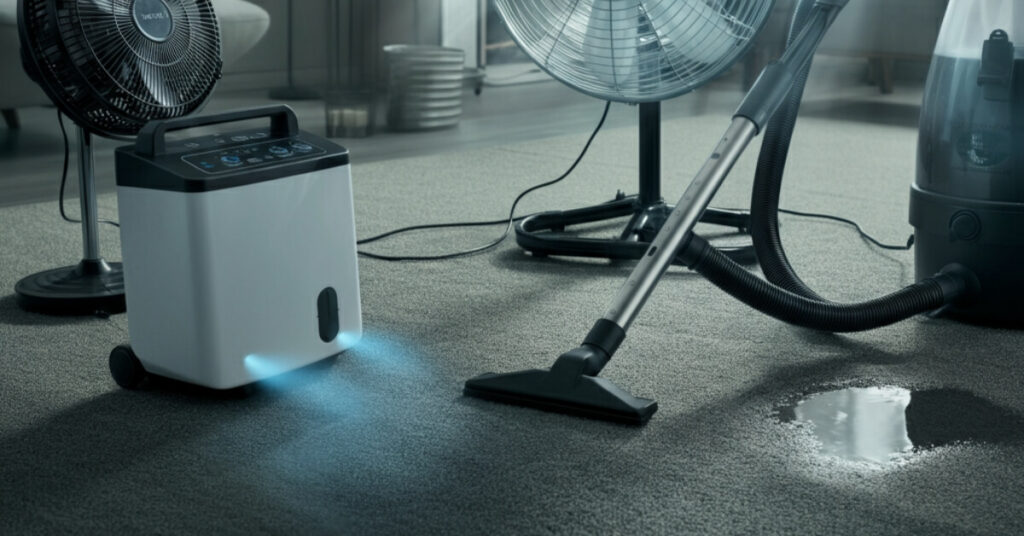Water damage can turn your comfortable home into a stressful situation overnight. When water infiltrates your carpets, whether from flooding, burst pipes, or roof leaks, immediate action becomes critical for successful restoration. Carpet cleaning and water damage recovery requires specific techniques, proper equipment, and quick decision-making to prevent permanent damage.
Water-damaged carpets face multiple threats beyond the obvious soaking. Moisture creates an ideal environment for mold growth, bacterial contamination, and structural damage to both the carpet fibers and underlying flooring. Furthermore, contaminated water introduces additional health risks that standard cleaning methods cannot address.
The key to successful carpet restoration lies in understanding the type of water damage, acting quickly, and using appropriate cleaning methods for your specific carpet type. While some water damage situations allow for DIY restoration, others require professional intervention to ensure safety and effectiveness. This comprehensive guide will walk you through the entire process, helping you make informed decisions about saving or replacing your water-damaged carpets.
Why Carpet Cleaning Is Crucial After Water Damage
Proper carpet cleaning after water damage serves as your first line of defense against long-term problems. Without immediate and thorough cleaning, seemingly minor water incidents can escalate into major health and structural issues.
Prevents Mold and Mildew Growth
Mold spores begin developing within 24-48 hours of water exposure. Once established, mold spreads rapidly throughout carpet fibers and padding, releasing harmful toxins into your indoor air. Additionally, mold remediation costs significantly exceed preventive carpet cleaning expenses.
Effective water damage cleaning eliminates moisture that feeds mold growth. Professional-grade dehumidifiers and proper ventilation create an environment where mold cannot survive. Therefore, acting within the first 24 hours dramatically increases your chances of preventing mold contamination.
Protects Indoor Air Quality
Water-damaged carpets release various airborne contaminants that compromise respiratory health. Bacteria, dust mites, and volatile organic compounds multiply rapidly in moist environments. Consequently, family members may experience increased allergies, asthma symptoms, and respiratory infections.
Thorough cleaning and sanitization remove these contaminants before they become airborne. Moreover, proper drying techniques prevent the musty odors associated with water damage, maintaining a healthy living environment for your family.
Extends Carpet Lifespan
Quality carpets represent a significant investment in your home’s comfort and value. Water damage doesn’t automatically mean replacement if you respond quickly and appropriately. Professional carpet cleaning and water damage restoration can salvage carpets that might otherwise require costly replacement.
However, delaying proper cleaning allows water to break down carpet fibers, adhesives, and backing materials. This deterioration becomes irreversible, forcing premature carpet replacement and unnecessary expenses.
Avoids Structural Damage to Flooring
Water damage extends beyond carpet surfaces to affect subfloors, floor joists, and surrounding structures. Moisture trapped beneath carpets warps hardwood, weakens adhesives, and promotes rot in wooden components. Therefore, proper carpet cleaning and water damage restoration protects your home’s structural integrity.
Effective moisture removal prevents water from seeping into subfloor materials. This protection saves thousands of dollars in structural repairs and maintains your home’s stability and value.
How to Clean Carpets After Water Damage (Step-by-Step)
Successful carpet restoration follows a systematic approach that addresses both immediate water removal and long-term damage prevention. Each step builds upon the previous one, creating a comprehensive restoration process.
Assess the Damage
Begin by determining the water source and contamination level. Clean water from supply lines poses fewer health risks than gray water from appliances or black water from sewage. This assessment determines your cleaning approach and safety precautions.
Document the damage with photos for insurance claims. Measure the affected area and note any visible staining, odors, or carpet deformation. Furthermore, check surrounding areas for hidden moisture using a moisture meter if available.
Remove Excess Water
Start water extraction immediately using wet/dry vacuums or carpet extractors. Work systematically across the affected area, overlapping passes to ensure complete water removal. Additionally, use fans and open windows to promote air circulation and faster drying.
For severe flooding, consider renting commercial-grade water extraction equipment. These powerful machines remove significantly more water than household vacuums, reducing drying time and preventing secondary damage.
Use Professional-Grade Drying Equipment
Position industrial fans, dehumidifiers, and air movers throughout the affected area. Create airflow patterns that promote evaporation while preventing moisture concentration in corners or enclosed spaces. Moreover, monitor humidity levels to ensure consistent progress toward complete drying.
Professional restoration companies use specialized equipment that achieves optimal drying conditions. If DIY efforts aren’t producing results within 48 hours, professional intervention becomes necessary to prevent mold growth.
Deep Clean and Sanitize
Once excess moisture is removed, deep clean the carpet using appropriate cleaning solutions. Hot water extraction removes embedded dirt and contaminants while sanitizing agents eliminate bacteria and odors. Therefore, this step ensures both cleanliness and health safety.
Choose cleaning products designed specifically for water damage restoration. These formulations address the unique challenges of water-damaged carpets, including odor elimination and antimicrobial protection.
Inspect for Mold and Odors
After cleaning and initial drying, inspect carpets carefully for signs of mold growth or persistent odors. Look for discoloration, fuzzy growth, or musty smells that indicate ongoing moisture problems. Subsequently, address any issues immediately to prevent spread.
Professional mold testing may be necessary if you suspect contamination but cannot locate visible growth. Early detection and treatment prevent extensive remediation requirements and protect your family’s health.
Best Tools and Products for Water-Damaged Carpet Cleaning

Selecting appropriate equipment and products significantly impacts restoration success. Professional-grade tools offer superior performance but require proper training and safety precautions.
Wet/Dry Vacuums
High-capacity wet/dry vacuums provide the foundation for water extraction. Look for models with strong suction power, large tank capacity, and carpet-specific attachments. Additionally, ensure the vacuum can handle the volume of water without motor damage.
Commercial-grade extractors offer superior performance for extensive water damage. These machines combine powerful suction with heated drying capabilities, reducing restoration time and improving results.
Dehumidifiers
Dehumidifiers control ambient moisture levels, preventing mold growth and accelerating drying. Refrigerant dehumidifiers work effectively in warm conditions, while desiccant models perform better in cooler environments. Therefore, choose the appropriate type for your specific situation.
Calculate dehumidifier capacity based on room size and moisture level. Undersized units cannot maintain proper humidity levels, while oversized units may over-dry the air and damage sensitive materials.
Carpet Shampoos and Disinfectants
Water damage restoration requires specialized cleaning products that address contamination and odor concerns. Antimicrobial solutions eliminate bacteria and prevent mold growth, while enzymatic cleaners break down organic contaminants.
Avoid household cleaning products that may leave residues or react poorly with carpet materials. Professional restoration products provide superior cleaning power while protecting carpet fibers and colors.
Steam Cleaners vs. Dry Cleaning Methods
Steam cleaning uses hot water extraction to remove deep-seated contaminants and moisture. This method provides thorough cleaning but requires extended drying time. Conversely, dry cleaning methods use minimal moisture but may not address all contamination concerns.
For water damage restoration, steam cleaning typically provides better results despite longer drying requirements. However, delicate carpets or severe moisture problems may benefit from dry cleaning approaches.
How to Handle Different Carpet Types (Wool, Synthetic, Berber, Plush)

Different carpet materials require specific cleaning approaches to prevent damage while achieving optimal restoration results. Understanding these differences ensures successful carpet cleaning and water damage recovery.
Cleaning Techniques by Material
Wool carpets require gentle cleaning methods and pH-neutral solutions to prevent fiber damage and color bleeding. Use cool water temperatures and avoid harsh chemicals that can weaken natural fibers. Additionally, wool takes longer to dry and requires careful monitoring for shrinkage.
Synthetic carpets, including nylon and polyester, tolerate more aggressive cleaning methods and higher temperatures. These materials resist staining and maintain their appearance through intensive cleaning processes. However, heat-sensitive synthetics require temperature monitoring to prevent melting.
Berber carpets present unique challenges due to their looped construction, which can trap contaminants and moisture. Use low-moisture cleaning methods and avoid aggressive scrubbing that might snag or unravel loops. Furthermore, focus on thorough drying to prevent moisture retention in the dense fiber structure.
Drying Times and Precautions
Carpet material significantly affects drying time and restoration success. Dense materials like plush carpets retain more moisture and require extended drying periods. Conversely, low-pile carpets dry quickly but may show water stains more readily.
Monitor drying progress regularly and adjust equipment placement as needed. Some materials may require professional treatment to achieve complete moisture removal and prevent secondary damage.
When Replacement Is Better Than Restoration
Certain situations make replacement more cost-effective than restoration. Severely damaged carpets, extensive mold contamination, or repeated water incidents often justify replacement. Additionally, older carpets may lack the structural integrity to survive intensive restoration processes.
Consider replacement when restoration costs approach 50% of replacement value. Professional assessment helps determine the most economical approach while ensuring family safety and home protection.
Taking Action for Successful Carpet Restoration
Successful carpet cleaning and water damage restoration depends on quick action, proper techniques, and realistic expectations about outcomes. While many water-damaged carpets can be saved with prompt intervention, some situations require professional expertise or complete replacement.
The first 24-48 hours after water damage are critical for preventing permanent damage and health hazards. During this window, focus on water extraction, moisture control, and initial cleaning efforts. Subsequently, continue monitoring and treatment until complete restoration is achieved.
Remember that water damage restoration extends beyond carpet cleaning to include padding replacement, subfloor treatment, and structural inspection. Professional restoration services provide comprehensive solutions that address all aspects of water damage, ensuring complete recovery and preventing future problems.
Frequently Asked Questions
Can water-damaged carpet be saved?
Yes, water-damaged carpets can often be saved if restoration begins within 24-48 hours. Success depends on water type, contamination level, and carpet material.
How long does it take to dry a wet carpet?
Wet carpets typically take 12-48 hours to dry completely with proper equipment. Dense materials and high humidity extend drying time significantly.
What are the signs of mold in carpet?
Look for discoloration, musty odors, fuzzy growth, or increased allergy symptoms. Mold often appears as dark spots or patches on carpet surfaces.
Should I replace padding under water-damaged carpet?
Yes, carpet padding should usually be replaced after water damage. Padding retains moisture and contaminants that cannot be effectively cleaned.
Is professional carpet cleaning necessary after flooding?
Professional cleaning is recommended for extensive flooding, contaminated water, or when DIY efforts aren’t producing results within 48 hours.


